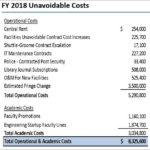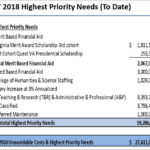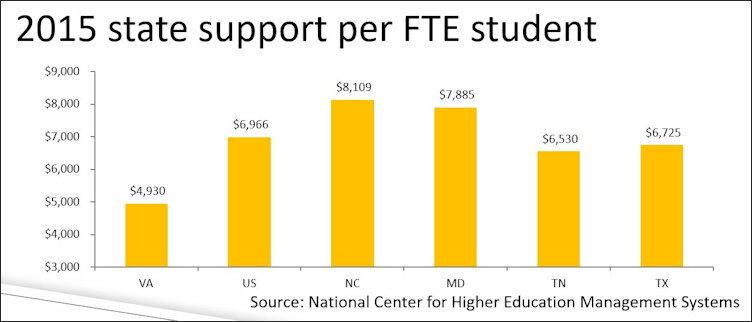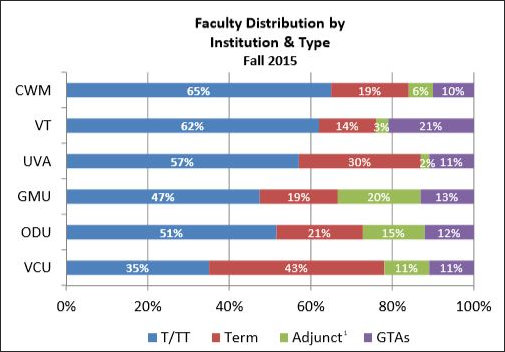The Virginia Commonwealth University Board of Visitors approved a 3.8% tuition & fee increase for in-state undergraduate students today, which, along with increases on out-of-state students and dentistry students will yield a 6.4% increase in overall tuition & fees — an increase of $25.7 million.
The increases help offset an $11 million reduction in state support in the 2017-2018 budget and cover other rising costs. The budget provides a $5.1 million increase in financial aid to students, $12 million for a 3% raise for faculty and staff, $8.3 million in “unavoidable” operational and academic costs, and millions more in “highest priority” needs.
“This is a lean budget that addresses unavoidable and operational costs and focuses on our highest priority needs,” said VCU President Michael Rao in a prepared statement. “We are mindful of the cost and burden on students and their families and have increased the amount of university financial aid to students. We are also mindful that we must provide a quality education expected by high-performing students at a major public research university. This is what our students expect and deserve.”
The tuition increase will add about $494 to the annual cost of attendance for a full-time in-state undergraduate student. Smaller increases in dormitories, dining and parking will add even more.
Robert Holsworth, a former dean of the College of Humanities and Sciences, was the only board member to question the tuition increase. Referring to the budget presentation by Karol Kain Gray, vice president of finance, he noted, “There hasn’t been a slide that deals with student debt. We now have the largest student debt of any public university in the state. Other universities have done a better job with affordability.”
VCU is “doing a lot of good things,” Holsworth said, but “I am concerned that we’re … losing our commitment to affordability.”
There followed a train of comments by other board members deploring tuition increases and high student indebtedness but justifying the hikes as necessary to maintain academic quality in the face of state budget cuts and increasing expenses.
The one concrete proposal from that exchange came from G. Richard Wagoner Jr., former CEO of General Motors. Instead of budgeting in one-year cycles, he suggested, perhaps VCU could adopt a longer perspective and ask what kind of tuition policy it wants to have. “What’s a desirable policy?” he asked. Zero increases in tuition? Tuition increases that keep place with inflation? Tuition increases that equal inflation plus two percent?
“I could not agree with you more,” said Rector John A. Luke, Jr., former CEO of MeadWestvaco, although he noted that over the long term the increase in tuition “almost mirrors exactly” cuts in state support. He said VCU needs to find a way to avoid being “held hostage” to the state’s budgetary needs.
William M. Ginther, a retired banking executive, suggested that VCU needs a “business strategic plan” to accompany its budget plan to develop new revenue options and identify cost-cutting opportunities.
No action was taken on any of these ideas. But the board did vote to adopt the budget and tuition increases. Holsworth voted no.
Bacon’s bottom line: I have attempted to fairly describe the meeting highlights above. Now for some analysis. The board meeting saw little substantive discussion about the budget. Other than Holsworth, not one board member pushed back on the administration’s presentation of the budget or its justification for raising fees. I did not attend the earlier finance committee hearings in which the budget was examined in greater detail, but no one alluded to any disagreements in those meetings either.

VCU’s “unavoidable costs.” Click the thumbnail for a legible image.
The administration almost pre-determined the outcome by the way it framed the budget presentation. The FY 2017 budget was taken as a baseline — nothing was questioned — and new costs and programs were layered on top. Click on the thumbnail to the left to see the list of $8.3 million in “unavoidable” costs: everything from shuttle service and library journals to faculty promotions to operations & maintenance on new buildings.

Highest-priority needs. Click for legible image.
To those costs VCU added “highest priority needs” such as $1.8 million in merit-based financial aid, $3 million in need-based financial aid, and implementing a 3% increase in salary and compensation for faculty and staff. These and other priorities amounted to $19.3 million.
VCU picked a tuition increase — 3.8% — that closed most of the gap. A $3.8 million budget shortfall remains, which will be addressed “at the unit level across the university,” according to the press release.
VCU administrators provided data showing how state funding is chintzy compared to that of other states — as, in fact it is. Virginia’s $4,930 per student ranks 44th among the states, far less than the $6,966 national average.

But in a nearly $1.2 billion budget, there are many ways that VCU did not explore to make up the loss of $8 million in state support. For example, the administration provided no analysis of what private businesses would call product line profitability. VCU supports a wide variety of schools and departments — academic product lines — but the public, and board members, have no way of telling whether the courses are fully subscribed or ill attended. Businesses sell or shut down unprofitable product lines. VCU’s approach to the budget effectively treats every budget and department as sacrosanct.
VCU also is spending millions of dollars constructing new buildings, but there was no analysis of campus-wide space needs. Are classrooms and lecture halls fully utilized? Many private-sector businesses are deploying “hoteling” and other techniques to reduce the square footage of office space per employee. Is VCU doing anything to reduce the square footage needs of faculty, staff and students?
The board of trustees heard a presentation today describing a sweeping redesign of the university’s human resources system. The goal is to make VCU a “great place to work” by keeping the things people like about being a state employee (sweet pension and medical benefits) and offering private-sector goodies like merit pay, all within a budget-neutral framework. Most commendable. But the administration missed an opportunity to shed light on VCU’s workforce productivity.
The board did briefly lay eyes upon an interesting chart:

This shows how VCU relies more heavily upon non-tenured instructors and adjunct faculty than Virginia’s other research universities. These non-tenured employees are cheaper to employ than Ph.D. professors but they don’t conduct research and are considered less prestigious in “best university” rankings. The paucity of tenured professors is widely thought to reflect poorly on the quality of the learning experience — even though tenure-track faculty teach less.
Is that conventional wisdom accurate? Many universities have faculty caste systems in which highly paid full professors carry light course loads and teach few students while lower-paid instructors carry much of the teaching burden. Clearly, VCU runs much leaner than its Virginia peers. The administration missed an opportunity to cast itself in a favorable light — and, perhaps, to find ways to squeeze even more productivity from its faculty.
Perhaps the most important issue not discussed is one I raised in a recent post, “VCU Ponders Risky 5.3% Tuition Hike.” VCU offers a dubious value proposition. It charges the second highest tuition & fees among public Virginia institutions, but its students have among the lowest family incomes. Even though performance is improving, fewer than 60 percent of underrepresented minorities graduate within six years, often due to an inability to pay tuition, fees, books, room, board and miscellaneous expenses. As Holsworth pointed out, 65% of students carry debt, and the average indebtedness (presumably for graduates) exceeds $30,000. VCU is expensive for a public university and, despite modest increases in financial aid, students are hard pressed to afford it. At what point will applicants cry, “No mas!” and enrollment numbers start declining? No one on VCU’s board raised even raised the possibility. There is no indication in the materials presented to the board that the administration has given the matter any thought.
VCU needs board members willing to make waves and ask uncomfortable questions. I have yet to attend board meetings at other universities, but I’ll lay odds that the same is true elsewhere.


